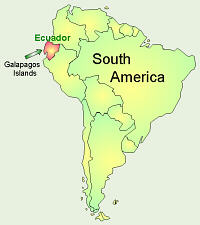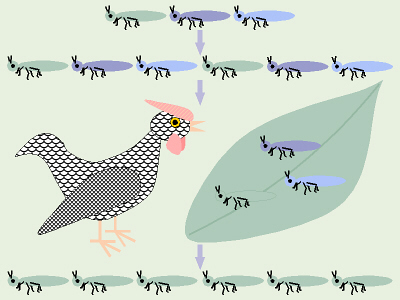Evolution and Darwin
A Brief Biography of Charles Darwin
Charles Darwin’s grandfather was a famous biologist, and his
father was a medical doctor. Charles started college studying medicine (he
was supposed to be a doctor “just like Dad”), but didn’t like it and dropped
out. He was interested in studying all the living organisms in the world
around him: he wanted to be a naturalist. In the 1800s, typically
most men who went to college and were not studying to become a doctor or
lawyer studied theology (theos = God, god), including
anyone who wanted to learn more about any of the sciences or mathematics.
Thus, Charles went back to school to study theology to be a naturalist,
studying under a chergyman who was a botanist. In typical college student
fashion, he eventually graduated, then decided to see the world before
settling down. Thus, at age 22, he got a job as ship’s naturalist on the
HMS Beagle and joined the crew as they sailed (literally) around the world.
While the sailors were busy keeping the ship headed in the right direction,
he was responsible for doing a survey of the flora (plants) and
fauna (animals) living in the areas they visited. From England, the
ship sailed across the Atlantic, down the east coast of South America and
back up the west coast, then across the Pacific, past Australia, around
Africa, and back to England.

Ecuador, South America
Darwin is especially noted for his work on the Galapagos Islands (located in
the Pacific Ocean off Ecuador, S. Amer.). On these islands, he found 14
species of finches (related to our goldfinches and housefinches). He
theorized that these 14 species were all derived from one species that had
somehow gotten there from the mainland, then diversified. Whereas most
finches eat seeds (our local goldfinches like thistle seed), some of
Darwin’s Finches eat large seeds, some eat small seeds, some eat insects,
and some even use cactus spines and twigs as tools to pry insects out of
crevices. Many more scientists have subsequently studied Darwin’s Finches,
and this has led to a whole specialized branch of biology called Island
Biogeography.
While, in general, after this trip, his health was not good,
Darwin did marry a woman from the Wedgewood family (as in Wedgewood Pottery).
Darwin spent years pouring over all the data he had collected, and forming
his famous theory, but put off publishing any of his results or ideas for
over 20 years. He did, however, attend scientific meetings and correspond
with other scientists of that time, so some other scientists were aware of
what he was working on.
“The Origin of Species...”
The story of how Darwin’s famous work finally came to be
published is interesting in that it is a good example of the “politics” of
science. In the late 1850s, a man named Alfred Russell Wallace had
developed a theory of evolution which was nearly identical to Darwin’s.
Then, as now, scientists presented papers at scientific meetings to share
their finding with others, and Wallace had requested time to speak at an
upcoming conference to officially put forth his theory. Some of Charles
Darwin’s friends, including Charles Lyell, heard about this and decided that
the credit should to to Darwin, not Wallace. They did this by asking the
meeting organizers for a few minutes, just before Wallace, to read
aloud excerpts from some of Darwin’s letters and notes to them which dealt
with his theory of evolution. Therefore, because Darwin’s theory was
presented first, he traditionally, has received all the credit (or blame) for
the theory of evolution, while until recently, hardly anyone had ever heard of
Alfred Russell Wallace. In general, in science, once someone has given a
talk at a conference, (s)he is expected to follow up by publishing the same
information in printed form, thus Darwin’s friends then pressured him to get
his theory published. Thus in 1859, The Origin of Species by Means of
Natural Selection or the Preservation of Favoured Races in the Struggle for
Life, better-know as The Origin of Species, was finally
published.
In this landmark book, Charles Darwin made four main points:

Summary of Darwin’s Theory
- individuals,
even siblings, in a population vary (there is variation),
- these
variations can be passed to offspring (are inherited),
- (from
Malthus) more offspring are produced than the environment can support, so
there is competition for resources, and
- those
individuals whose characteristics make them best suited to the environment
live and reproduce and have more offspring (survival of the
fittest).
Thus in any population, there is, as he put is, descent
with modification (changes occur over the generations) due to natural
selection (the “pressure” the environment puts on the various genetic
varieties in terms of their ability to cope and/or survive). Note that he
does not believe in the idea of an innate tendency toward greater
perfection (as Lamarck did), nor do organisms willfully “decided” to change,
nor does the environment cause any change to occur within an organism. What
he does say is that the environment does “select” various changes that
just happened to have occurred, in that these spontaneous changes make the
organism more or less able to cope with various factors in the
environment.
Besides his notes from his trip and his other studies, Darwin
also used artificial selection as justification/evidence for his
theory: if we, by breeding domesticated plants or animals for a number of
generations, can influence their genetics, then Darwin felt that this could
also happen in nature. Actually, Darwin never used the word “evolution”
(evolut = an unrolling). He used “descent with modification.”
Darwin’s thinking was influenced by the work of geologists and
paleontologists like Hutton, Smith, and Lyell, and by the work of
Malthus.
Modern Synthetic Theory of Evolution
In the 1930s and 40s, later people combined Darwin’s work,
Mendel’s work on genetics, and other new information to form what is called
The Modern Synthetic Theory of Evolution (synthetic in that it is
made up of or based on many smaller parts). Evolution refers to
change, or more specifically, the series of changes that have
transformed life on Earth from its beginnings until now. Besides
Darwin’s and Mendel’s works, this theory is also based on things like:
- Biogeography
- (geo = earth; graph = to write), the study of the
geographical (locations/regions) distribution of various organisms. An
especially important subcategory is island biogeography, the study
of island populations.
- Paleontology
- (paleo = ancient; onto = being, existing), the study of
fossils in rock strata
- Taxonomy
- (taxo = arrange, arrangement; -nomy = the science of),
the grouping of related species based on a) comparative anatomy
(ana = up; tom = to cut), especially focusing on homologous
structures (homo = same, like, alike). Frequently, organisms with
similar structures have common lineage, and b) comparative embryology:
the study of stages in embryonic development in various organisms. This
is summed up by the phrase “ontogeny recapitulates phylogeny”
(onto = being, existing; phylo = tribe; -geny =
production), which roughly means that the embryonic development of a
species goes through stages analogous to all the steps in the evolutionary
history of that species.
- Molecular Biology
- is based on similarities and/or differences in the “big” molecules
like proteins or DNA. The more closely-related any two species are, the
more macromolecules that are shared in their DNA.
Environmental pressure or natural selection “allows”
organisms with some genes/alleles to survive while others die. Eventually,
if enough genetic change accumulates, it can be said that a given population
of organisms is a different species than that from which it arose. In other
words, speciation has occurred. This adds up to the process of
evolution.
A thought for discussion/debate: while Darwin based his
theory in part on the idea of artificial selection, in which who gets to
breed with whom is decided by act of conscious reason, most biologists, now,
try to explain natural selection in terms of pure random chance.
Only a few biologists are willing to allow that natural selection may, like
artificial selection, also be an act of conscious reason.
Copyright © 1997 by J. Stein Carter. All rights reserved.
This page has been accessed  times since 15 Mar 2001.
times since 15 Mar 2001.

